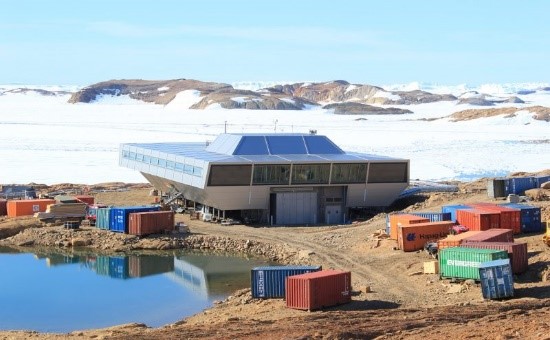Description

Disclaimer: Copyright infringement not intended.
Context
- Himadri, India’s Arctic Research Station at Ny-Ålesund in the Norwegian archipelago of Svalbard in the Arctic Ocean, will now remain operational throughout the year.
Bases in the Arctic
- At least 10 countries have set up permanent facilities at the International Arctic Research base in Ny-Ålesund, a small town above the 78th parallel N, about 1,200 km from the North Pole.
- The Svalbard group of islands is the closest human habitation to the North Pole.
- The mean temperature in Ny-Ålesund in February, the coldest month, is minus 14 degrees Celsius, and that in July, the warmest, is 5 degree Celsius. Due to the extreme cold, taking scientific observations or sampling has remained largely limited to the summer months. India will join a small group of countries that operate their Arctic research bases through the winter.

Arctic research
- The polar regions, Arctic and Antarctica, offer pristine environments for scientists to study a range of natural phenomena for atmospheric, oceanic, biological, geological, glaciological and earth sciences research.
- In recent years, climate change research has been attracting scientists to the Arctic region.
- Research stations of at least 11 countries, including India, Ny-Ålesund, Svalbard region of Norway.
- The area above the Arctic Circle, north of latitude 66° 34’ N, is part of eight countries — Canada, Denmark, Finland, Iceland, Norway, Russia, Sweden, and the US — who make up the Arctic Council, plus the Arctic Ocean.
- Scientific research in the Arctic region is governed by international legal instruments like the Svalbard Treaty of 1920 and the UN Convention on the Law of the Seas, apart from the individual jurisdictions of the Arctic countries.
Impact of Global Warming
- Temperatures in the Arctic region have risen by about 4 degrees Celsius on average over the last 100 years; 2023 was the warmest year on record.
- The extent of Arctic Sea ice has been declining at the rate of 13 percent/ decade, according to the Intergovernmental Panel on Climate Change. At this rate, the Arctic could become ice-free in less than 20 years.
- The melting sea ice can have global impacts reaching beyond the Arctic region. Rising sea levels can influence atmospheric circulation. An increase in tropical sea surface temperatures could lead to increased precipitation in the tropics, a shift in the Inter Tropical Convergence Zone, and high chances of an increase in extreme rainfall events.
- On the other hand, milder weather due to global warming could make the Arctic a more habitable and a less hostile place. There could be a rush to explore and exploit the Arctic’s resources, including its minerals, and countries will seek to control trade, navigation and other strategic sectors in the region.
India in the Arctic
- India signed the Svalbard Treaty in Paris in 1920. But it took until 2007 for the first Indian expedition comprising five scientists to visit the International Arctic Research Facilities at Ny-Ålesund to initiate studies in Arctic microbiology, atmospheric sciences, and geology.
- India’s permanent research station, Himadri, began operations in July 2008. (Note: Dakshin Gangotri in Antarctica was set up much earlier in 1983, two years after India’s first expedition there. Dakshin Gangotri is now submerged under ice, but India’s two other stations, Maitri and Bharti, are in use.)
- Himadri has so far hosted more than 400 Indian researchers who have made a total of about 200 visits to Svalbard.
- The winter expedition by scientists and the National Centre for Polar and Ocean Research, Goa, the nodal agency for India’s polar explorations, will last until January 15, 2024.
- The research areas will include atmospheric sciences, astronomy, astrophysics, and climate studies.
- Scientists will study lightning over the Arctic in winter, the role of precipitation in climate change, characterization of radio frequency environment, and the role of aerosols on climate change.
- Himadri has been equipped for observations during polar nights (that last longer than 24 hours), and supplied with special winter gear, transport, and logistics support from Norwegian agencies.

In a nutshell,
India's Research Stations in the Arctic and Antarctica
- India presently has two research stations at Antarctica namely ‘Maitri’ and ‘Bharati’.
- At both the stations, research and investigations are undertaken to understand the Polar processes and phenomenon.
- Observations and studies are carried out in atmospheric, biological, geological, ecological sciences etc.
- Maitri station has been in operation since 1989.
- Indian Arctic station ‘Himadri’ is located at Ny Alesund, Spitsbergen Island, Norway and serves as a hub of Indian scientific investigations since 2008. Also we do not have India has ice-breakers for exploration and research in the above places.
- In Antarctica scientific studies and investigations are undertaken on the continental part and contiguous shelf ice area.
- Observations in the ocean in the austral summer months are made during the voyage to ‘Maitri’ and ‘Bharati’ on board the chartered vessel hired for transport of material and personnel to these stations.
|
PRACTICE QUESTION
Q. Consider the following statements:
1. India signed the Svalbard Treaty in Paris in 1920.
2. 16 countries have set up permanent facilities at the International Arctic Research base in Ny-Ålesund.
3. India presently has three research stations at Antarctica namely ‘Maitri’, Himardri and ‘Bharati’.
Which of the above statements is/are incorrect?
A) 1 and 3 only
B) 2 and 3 only
C) 3 only
D) All
Answer: B) 2 and 3 only
|









